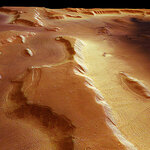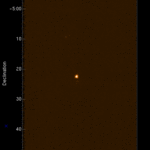Space
The sharpest image ever taken of the large "grand design" spiral galaxy M81 is being released today at the American Astronomical Society Meeting in Honolulu, Hawaii. A spiral-shaped system of stars, dust, and gas clouds, the galaxy's arms wind all the way down into the nucleus.
Click above for full size
This beautiful galaxy is tilted at an oblique angle on to our line of sight, giving a "birds-eye view" of the spiral structure. The galaxy is similar to our Milky Way, but our favorable view provides a better picture of the typical architecture of spiral galaxies. Though the galaxy is 11.6…

On 12 May 2007 Cassini obtained this image showing the coastline and an archipelago in a portion of a large sea, consistent with the larger sea seen by the Cassini imaging instrument.
Like other liquid bodies seen on Titan, this feature reveals channels, islands, bays, and other features typical of terrestrial coastlines and the liquid, most likely a combination of methane and ethane, appears very dark in radar. What is striking about this portion of the sea compared to other liquid bodies on Titan is the relative absence of brighter regions within it, suggesting that the depth of the liquid…
When Dutch astronomer Willem de Sitter proposed a static model of the universe in the early 1900s, he was some 3 trillion years ahead of his time.
Now, physicists Lawrence Krauss from Case Western Reserve University and Robert J. Scherrer from Vanderbilt University predict that trillions of years into the future, the information that currently allows us to understand how the universe expands will have disappeared over the visible horizon. What remains will be "an island universe" made from the Milky Way and its nearby galactic Local Group neighbors in an overwhelmingly dark void.
Lawrence…

Plasma astrophysicists at the University of Warwick have found that key information about the Sun’s 'storm season’ is being broadcast across the solar system in a fractal snapshot imprinted in the solar wind. This research opens up new ways of looking at both space weather and the unstable behaviour that affects the operation of fusion powered power plants.
Fractals, mathematical shapes that retain a complex but similar patterns at different magnifications, are frequently found in nature from snowflakes to trees and coastlines. Now Plasma Astrophysicists in the University of Warwick’s Centre…
The University of Delaware is helping to build a huge "IceCube" at the South Pole, and it has nothing to do with cooling beverages.
"IceCube" is a gigantic scientific instrument--a telescope for detecting illusive particles called neutrinos that can travel millions of miles through space, passing right through planets.
The IceCube telescope's optical detectors are deployed in mile-and-a-half deep holes in the Antarctic ice. Credit: James Roth, University of Delaware
A poet might refer to them as stardust or ghosts from outer space. But to astrophysicists, neutrinos are the high-energy…

The High Resolution Stereo Camera (HRSC) on board ESA’s Mars Express has captured breathtaking images of the Deuteronilus Mensae region on Mars.
The images were taken on 14 March 2005 during orbit number 1483 of the Mars Express spacecraft with a ground resolution of approximately 29 metres per pixel.
This image shows a perspective view of the Deuteronilus Mensae region on Mars. It was taken on 14 March 2005 by the High-Resolution Stereo Camera (HRSC) onboard ESA’s Mars Express with a ground resolution of approximately 29 metres per pixel. It is believed that the valleys visible in the image…

A patch of Martian soil analyzed by NASA's rover Spirit is so rich in silica that it may provide some of the strongest evidence yet that ancient Mars was much wetter than it is now. The processes that could have produced such a concentrated deposit of silica require the presence of water.
Members of the rover science team heard from a colleague during a recent teleconference that the alpha particle X-ray spectrometer, a chemical analyzer at the end of Spirit's arm, had measured a composition of about 90 percent pure silica for this soil.
"You could hear people gasp in astonishment," said…
Astronomers have used powerful adaptive optics technology at the W. M. Keck Observatory in Hawai‘i to reveal the precise locations and environments of a pair of supermassive black holes at the center of an ongoing collision between two galaxies 300 million light-years away.
The new observations of the galaxy merger known as NGC 6240 reveal that each of the black holes resides at the center of a rotating disk of stars and is surrounded by a cloud of young star clusters formed in the merger.
An adaptive optics image of the double nucleus of the galaxy merger NGC 6240, taken in infrared light…

The James Clerk Maxwell Telescope (JCMT) on Mauna Kea in Hawaii has a new way to look at the Universe, thanks to two revolutionary instruments called HARP and ACSIS. These instruments operate together, and they recently sliced through the Orion Nebula, recording for the first time the internal movements of its star-forming gases.
This movie takes the observer through the data cube and gives a feel of how the gas is moving. The movie starts with clouds in the southern region, and then shows them progressively more towards the north as it steps through the wavelength slices. This reveals an…
Astronomers have discovered the exact location and makeup of a pair of supermassive black holes at the center of a collision of two galaxies more than 300 million light years away.
Using adaptive optics (AO), which clear the blurring effects of turbulence in the Earth's atmosphere, Livermore scientists observed that the two black holes formed at the center of a rotating disk of stars in the galaxy merger known as NGC 6240 and are surrounded by a cloud of young star clusters.
Over the course of the next few hundred million years,, the two supermassive black holes, which are about 3,000 light…